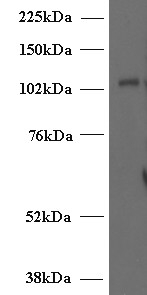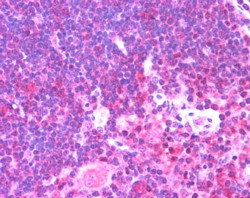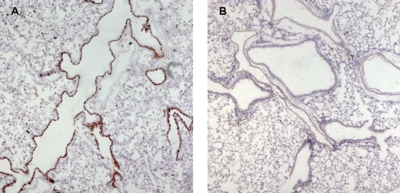Goat Anti-Munc13-4 / UNC13D (Internal) Antibody
Peptide-affinity purified goat antibody
- SPECIFICATION
- CITATIONS
- PROTOCOLS
- BACKGROUND

Application
| WB, IHC, E |
|---|---|
| Primary Accession | Q70J99 |
| Other Accession | NP_954712, 201294, 70450 (mouse), 192177 (rat) |
| Reactivity | Human, Mouse |
| Predicted | Rat, Pig, Dog |
| Host | Goat |
| Clonality | Polyclonal |
| Concentration | 100ug/200ul |
| Isotype | IgG |
| Calculated MW | 123282 Da |
| Gene ID | 201294 |
|---|---|
| Other Names | Protein unc-13 homolog D, Munc13-4, UNC13D |
| Dilution | WB~~1:1000 IHC~~1:100~500 E~~N/A |
| Format | 0.5 mg IgG/ml in Tris saline (20mM Tris pH7.3, 150mM NaCl), 0.02% sodium azide, with 0.5% bovine serum albumin |
| Storage | Maintain refrigerated at 2-8°C for up to 6 months. For long term storage store at -20°C in small aliquots to prevent freeze-thaw cycles. |
| Precautions | Goat Anti-Munc13-4 / UNC13D (Internal) Antibody is for research use only and not for use in diagnostic or therapeutic procedures. |
| Name | UNC13D |
|---|---|
| Function | Plays a role in cytotoxic granule exocytosis in lymphocytes. Required for both granule maturation and granule docking and priming at the immunologic synapse. Regulates assembly of recycling and late endosomal structures, leading to the formation of an endosomal exocytic compartment that fuses with perforin-containing granules at the immunologic synapse and licences them for exocytosis. Regulates Ca(2+)- dependent secretory lysosome exocytosis in mast cells. |
| Cellular Location | Cytoplasm. Membrane; Peripheral membrane protein. Late endosome. Recycling endosome. Lysosome. Note=Colocalizes with cytotoxic granules at the plasma membrane. Localizes to endosomal exocytic vesicles |
| Tissue Location | Expressed at high levels in spleen, thymus and leukocytes. Also expressed in lung and placenta, and at very low levels in brain, heart, skeletal muscle and kidney. Expressed in cytotoxic T- lymphocytes (CTL) and mast cells. |

Thousands of laboratories across the world have published research that depended on the performance of antibodies from Abcepta to advance their research. Check out links to articles that cite our products in major peer-reviewed journals, organized by research category.
info@abcepta.com, and receive a free "I Love Antibodies" mug.
Provided below are standard protocols that you may find useful for product applications.
Background
This gene encodes a protein that is a member of the UNC13 family, containing similar domain structure as other family members but lacking an N-terminal phorbol ester-binding C1 domain present in other Munc13 proteins. The protein appears to play a role in vesicle maturation during exocytosis and is involved in regulation of cytolytic granules secretion. Mutations in this gene are associated with familial hemophagocytic lymphohistiocytosis type 3, a genetically heterogeneous, rare autosomal recessive disorder.
References
UNC13D is the predominant causative gene with recurrent splicing mutations in Korean patients with familial hemophagocytic lymphohistiocytosis. Yoon HS, et al. Haematologica, 2010 Apr. PMID 20015888.
Different NK cell-activating receptors preferentially recruit Rab27a or Munc13-4 to perforin-containing granules for cytotoxicity. Wood SM, et al. Blood, 2009 Nov 5. PMID 19704116.
Neonatal primary hemophagocytic lymphohistiocytosis in Turkish children. Gurgey A, et al. J Pediatr Hematol Oncol, 2008 Dec. PMID 19131769.
Microbe sensing, positive feedback loops, and the pathogenesis of inflammatory diseases. Beutler B. Immunol Rev, 2009 Jan. PMID 19120489.
Macrophage activation syndrome in patients with systemic juvenile idiopathic arthritis is associated with MUNC13-4 polymorphisms. Zhang K, et al. Arthritis Rheum, 2008 Sep. PMID 18759271.
If you have used an Abcepta product and would like to share how it has performed, please click on the "Submit Review" button and provide the requested information. Our staff will examine and post your review and contact you if needed.
If you have any additional inquiries please email technical services at tech@abcepta.com.













 Foundational characteristics of cancer include proliferation, angiogenesis, migration, evasion of apoptosis, and cellular immortality. Find key markers for these cellular processes and antibodies to detect them.
Foundational characteristics of cancer include proliferation, angiogenesis, migration, evasion of apoptosis, and cellular immortality. Find key markers for these cellular processes and antibodies to detect them. The SUMOplot™ Analysis Program predicts and scores sumoylation sites in your protein. SUMOylation is a post-translational modification involved in various cellular processes, such as nuclear-cytosolic transport, transcriptional regulation, apoptosis, protein stability, response to stress, and progression through the cell cycle.
The SUMOplot™ Analysis Program predicts and scores sumoylation sites in your protein. SUMOylation is a post-translational modification involved in various cellular processes, such as nuclear-cytosolic transport, transcriptional regulation, apoptosis, protein stability, response to stress, and progression through the cell cycle. The Autophagy Receptor Motif Plotter predicts and scores autophagy receptor binding sites in your protein. Identifying proteins connected to this pathway is critical to understanding the role of autophagy in physiological as well as pathological processes such as development, differentiation, neurodegenerative diseases, stress, infection, and cancer.
The Autophagy Receptor Motif Plotter predicts and scores autophagy receptor binding sites in your protein. Identifying proteins connected to this pathway is critical to understanding the role of autophagy in physiological as well as pathological processes such as development, differentiation, neurodegenerative diseases, stress, infection, and cancer.




